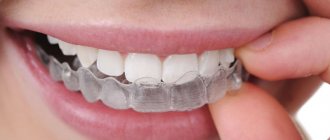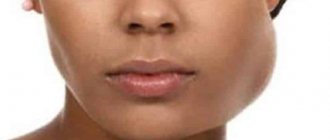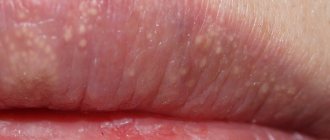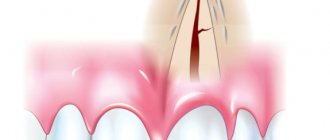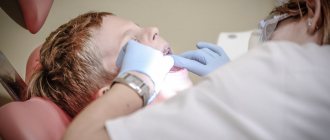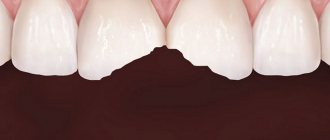Main causes How to treat?
Prevention Where to go? We find the toothless smiles of little children charming. With adults the situation is different. Missing teeth not only spoils your smile, it greatly reduces your quality of life. Tooth loss changes diction and leads to disruption of the oval of the face. Food is not chewed fully, problems with the gastrointestinal tract and defects of the jaw joints develop. Loss of teeth can lead to social isolation, depression, and neurological disorders.
Why do teeth fall out? The reasons are different, from injuries to inflammatory diseases of the oral cavity.
Caries
The most common cause of tooth loss is tooth decay. With this disease, the tooth crown is destroyed and the root system is weakened, as a result of which the tooth simply falls out. This happens if caries is not treated and oral hygiene is not maintained.
In this case, the tooth root, as a rule, remains in the bone tissue under the gum and if it is not removed in time, inflammation may develop.
To prevent tooth loss, you need to contact your dentist at the first signs of caries; these may be:
- the presence of carious cavities are dark spots on the tooth enamel. At the initial stage of the disease, they may not be present, or the patient may not see them on their own.
- pain when the tooth gets hot/cold, or sour, sweet or salty food and liquid;
- pain when pressing on the tooth and when chewing;
- bad breath;
- in the later stages - severe destruction of the crown.
Tooth fell out: what to do
The loss of even one tooth leads to changes in the dentition and disruption of the dental system. As a result, a number of problems can arise:
- improper jaw closure
- increased stress on healthy teeth
- overload of facial muscles and temporomandibular joints
- headache
If all the teeth have fallen out, the proportions of the face change, and the person seems older than he really is. Therefore, in case of partial or complete adentia, it is necessary to restore the integrity of the dentition as quickly as possible. One of the most effective methods is implantation.
The artificial root performs all the functions of a real one and is securely fixed in the bone tissue. An aesthetic crown is installed on it. Thanks to the high precision of manufacturing, it is completely indistinguishable from real teeth.
Implants will help restore the functioning of the dental system, even if all teeth have fallen out, thanks to the All-on-4 and All-on-6 prosthetic methods. Implantation is the only way to completely restore the dentition without the sensation of artificial teeth.
The loss of even one tooth negatively affects the functioning of the dental system, so it is better to promptly seek help from a dentist. He will find out the cause of tooth loss in adults and prescribe effective treatment that will help avoid functional changes.
Periodontal disease
Periodontal disease is a disease that affects the gums and bone tissue around the tooth. With periodontal disease, atrophy of gum tissue occurs, so-called gum pockets are formed, and bacterial plaque is deposited in them, provoking further inflammation. The gums around the tooth shrink, exposing the lower part and, in some cases, the root. And the tooth itself gradually loosens and leaves the tooth socket.
Periodontal disease is often accompanied by inflammation, bad breath, sore gums, and increased tooth sensitivity.
But periodontal disease leads to tooth loss only in an advanced stage if measures are not taken for a long time. If you consult a doctor at the first signs of illness, unpleasant consequences can be avoided. And if you follow hygiene rules and do not overindulge in sweets, then the development of periodontal disease itself can be prevented.
The best way to fill a defect in the dentition is implantation
There are several technologies for dental prosthetics for partial loss. Today, the best way to restore teeth is implantation. This method is the most reliable (modern implants take root in 98-99% of cases, service life is more than 20 years and even a lifetime), the most aesthetic, functional and comfortable to use, because implants imitate the root of a tooth. It is also very important that during implantation there is no need to grind down adjacent healthy teeth.
The only thing better than implantation is your own tooth!
When a front molar is lost, implantation with immediate loading is often performed. With its help, the dentist immediately after installing the implant, without waiting for its osseointegration, installs a temporary crown that covers the aesthetic defect. The temporary crown is removed from the bite and is often bonded to adjacent teeth. After 2-6 months, the temporary crown is replaced with a permanent one. Immediate loading is carried out for aesthetic, not medical reasons. When a tooth is 100% subject to extraction (for example, with a longitudinal root fracture), but has not yet been removed, it is possible to perform an operation to remove the tooth and install an implant at the same time. In this case, the period of complete treatment is reduced by 3-4 months, and the cost is slightly reduced.
Periodontitis
Periodontitis is an inflammation of the soft tissues of the oral cavity. If left untreated, it causes weakening of the ligamentous apparatus of the tooth. The gum becomes inflamed, destroyed, the fixation of the tooth in the socket is weakened, under the influence of regular chewing load it becomes loose and eventually falls out. Often with periodontitis, the tooth root is exposed.
Periodontitis causes not only poor oral health and bacteria, but also allergic reactions, gum injuries, hormonal imbalance, weakened immunity and a number of other reasons.
Moreover, if periodontitis is generalized, that is, spread over the entire jaw, the matter may not be limited to one lost tooth and other dental units will follow. If periodontitis is not treated at all, it can lead to complete edentia.
The first signs of the disease, for which you should go to the clinic, are bleeding gums, discomfort, and itching. This may be followed by pain when chewing, an unpleasant odor, and purulent discharge.
In severe periodontitis, the teeth become displaced and loosened, exposing the lower part of the tooth and the root. The disease should definitely not be brought to this stage, since it can only be cured through surgery.
Why do teeth fall out
Each tooth is located in its own socket and is securely held in it thanks to the periodontium. This is a whole complex of tissues, which includes root cement, dentogingival ligament and alveolar bone. They perfectly perform supporting and holding functions until inflammatory processes begin in the tissues. As a rule, the latter occur due to poor oral hygiene.
Within two hours after brushing your teeth, plaque begins to accumulate on them. It consists of food particles, saliva, the minerals it contains, and bacteria. There are especially many of them near the gums and between the teeth. Over time, plaque mineralizes and turns into tartar. It is the main cause of most dental diseases, including those associated with periodontal disease.
Inflammation of the tissues holding the tooth in the socket can be quite severe against the background of metabolic disorders, diabetes mellitus, thyroid disease, hypovitaminosis and osteoporosis.
Age-related changes
If the main causes of adentia can be identified and neutralized in time, age-related tooth loss is an inevitable phenomenon. In old age, the immune system weakens, the gums atrophy and decrease in volume, the neck of the tooth becomes exposed, teeth become mobile and fall out.
Most often this happens at the age of 65-70, but if the patient did not take care of his teeth and did not follow preventive recommendations, negative consequences may appear earlier.
It is not possible to prevent this, but you can delay it by taking vitamins, medications that boost immunity, carefully monitor your physical condition and lead a healthy lifestyle.
What to do to prevent dental problems
Since childhood, we know that we need to take care of our teeth. Loving parents instill a healthy habit; they teach about brushing teeth in kindergarten and then at school. Unfortunately, even if you brush your teeth correctly, it is impossible to completely remove all plaque at home. For this purpose, there is special dental equipment that allows you to remove all types of deposits, even in hard-to-reach places. The procedure is called “professional hygiene” and is carried out twice a year. High-quality care will help avoid many problems with teeth and gums.
Other Possible Causes
In addition to oral diseases, other factors can cause edentia:
- diabetes mellitus, in which blood sugar levels are abnormal, leading to excess glucose. This, in turn, provokes a disruption of the blood supply to the gum tissues, which weaken and the tooth falls out;
- heart diseases, in most cases requiring regular use of medications that disrupt the functions of mucous tissues, which also leads to loss of teeth;
- hypertension and other chronic diseases;
- mechanical injuries;
- metabolic disease;
- weakened immunity;
- poor diet, excessive sugar consumption;
- bad habits (smoking, excessive alcohol consumption, drug addiction);
- hereditary predisposition to adentia;
- failure to comply with hygiene standards and improper oral care, which provokes the growth of bacteria that weaken the gums and cause inflammation.
Prevention
To maintain healthy teeth for as long as possible, you need to eliminate the causes of tooth loss. To do this, just follow simple rules:
- brush your teeth thoroughly but gently;
- use dental floss;
- regularly have professional teeth cleaning;
- visit a doctor at least once every 6 months;
- to refuse from bad habits;
- establish a balanced diet;
- use protective mouthguards during training or extreme entertainment to avoid situations in which a tooth falls out.
How to prevent tooth loss
Preventing tooth loss is not so difficult; all you need to do is follow a few recommendations:
- Quitting smoking and alcohol.
- Normalization of diet, refusal of harmful foods, dyes, synthetic additives.
- Minimum sugar consumption or complete refusal of it.
- Avoiding sugary soda is the main enemy of healthy teeth.
- Maintaining hygiene means regularly brushing your teeth and rinsing with special solutions after meals.
- Regular professional cleaning of the oral cavity - removal of tartar and other deposits.
- If the immune system is weakened, take immunomodulators.
- Regular dental checkups.
If you have chronic diseases and other risk factors, you should pay increased attention to dental health and regularly visit a specialist. This will allow you to detect potential problems in time and eliminate them. But it is much simpler and cheaper than prosthetics.
Treatment
Medical intervention is carried out in two directions. The doctor's task:
- Prevent further tooth loss
- Restore dentition
In the first case, treatment depends on the diagnosis. This includes professional teeth cleaning, drug therapy, and remineralization (replenishing the lack of minerals).
The second direction is prosthetics. We discussed the risks of tooth loss at the beginning of the article. Therefore, the dentist’s task is to restore chewing function and the aesthetics of the smile. It is solved using:
- Fixed prosthetics
Bridges visually restore the dentition, but in reality they cannot evenly distribute the chewing load. They are recommended to be installed if 1-2 units are missing. In addition, in order to install a bridge, the adjacent teeth are depulped (the nerve is removed), depriving them of nutrition.
- Removable prosthetics
Removable dentures are used mainly in the absence of several or all teeth, and yoke dentures are used in the presence of at least 6 good ones. If the upper teeth are missing, then the plate dentures are quite firmly fixed due to suction to the upper palate. On the lower jaw you often have to use a special cream.
- Implantation
This is so far the only method that is as close as possible to natural teeth. The load on the implant stimulates metabolic processes and blood flow in the tissues. The bone tissue remains strong, maintaining the oval shape of the face and the youth of the smile. The load on the chewing teeth is distributed evenly. Well-chewed food does not irritate the mucous membranes. In addition, any type of prosthetics can be used on implants.

